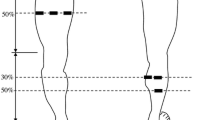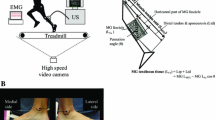Abstract
Purpose
We aimed to determine whether there are different changes in Achilles tendon (AT) mechanical properties in middle-aged, compared to younger runners that might indicate that tendon fatigue, induced by long-distance running, is age-dependent.
Methods
27 middle-aged (50–67 years) and 22 younger (21–29 years) participants ran a 21 km route at their own pace (mean and SD: old: 3.1 ± 0.3 m s−1; young: 3.6 ± 0.5 m s−1). We tested for changes in the AT force–elongation relationship using dynamometry and ultrasonography during isometric voluntary ankle plantarflexion ramp contractions, conducted 20–28 h pre-run, immediately pre-run, immediately post-run and 20–28 h post-run. Stride frequency and number were examined to estimate cyclic tensile loading characteristics of the tendon during running.
Results
Muscle strength decreased significantly (P < 0.05) in both groups immediately post-run (old: 17 %; young: 11 %) and recovered to baseline within 20–28 h post-run. AT stiffness did not change for the younger adults, whereas the middle-aged adults showed a significant (P < 0.05) decrease in AT stiffness (22 %). However, tendon stiffness recovered to baseline 20–28 h post-run. Middle-aged, compared to young adults, demonstrated significantly (P < 0.05) greater stride frequency and number, but no correlations with tendon fatigue changes were determined (R 2 ≤ 0.038).
Conclusions
The results suggest that the plasticity of the AT in response to short-term mechanical loading may be age dependent and that the AT length–tension properties of middle-aged runners may be more vulnerable to change following running compared to younger athletes. However, the observed AT changes in the middle-aged runners dissipated within 20–28 h post-run, suggesting that a tendon viscoelastic recovery mechanism may occur in vivo.





Similar content being viewed by others
Abbreviations
- 1dayPre-Run:
-
20–28 h before the run
- 1dayPost-Run:
-
Within 20–28 h after the run
- AT:
-
Achilles tendon
- ANOVA:
-
Analysis of variance
- CSA:
-
Cross-sectional area
- GM:
-
Gastrocnemius medialis
- imPre-Run:
-
Immediately before the run
- imPost-Run:
-
Immediately after the run
- MTU:
-
Muscle–tendon unit
- MVC:
-
Maximal voluntary plantarflexion ramp contraction
- SD:
-
Standard deviation
References
Arampatzis A, Stafilidis S, DeMonte G, Karamanidis K, Morey-Klapsing G, Brüggemann GP (2005) Strain and elongation of the human gastrocnemius tendon and aponeurosis during maximal plantarflexion effort. J Biomech 38:833–841
Arampatzis A, Karamanidis K, Stafilidis S, Morey-Klapsing G, DeMonte G, Brüggemann GP (2006) Effect of different ankle-and knee-joint positions on gastrocnemius medialis fascicle length and EMG activity during isometric plantar flexion. J Biomech 39:1891–1902
Beaumont PWR (1989) The failure of fibre composites: an overview. J Strain Anal Eng 24:189–205
Biewener AA, Roberts TJ (2000) Muscle and tendon contributions to force, work, and elastic energy savings: a comparative perspective. Exerc Sport Sci Rev 28:99–107
Bjornsson HC, Norlin R, Johansson K, Adolfsson LE (2011) The influence of age, delay of repair, and tendon involvement in acute rotator cuff tears: structural and clinical outcomes after repair of 42 shoulders. Acta Orthop 82:187–192
Brunet ME, Cook SD, Brinker MR, Dickinson JA (1990) A survey of running injuries in 1505 competitive and recreational runners. J Sport Med Phys Fit 30:307–315
Clement DB, Taunton JE, Smart GW (1984) Achilles tendinitis and peritendinitis: etiology and treatment. Am J Sport Med 12:179–184
Dahners LE, Banes AJ, Burridge KW (1986) The relationship of actin to ligament contraction. Clin Orthop Relat Res 210:246–251
Farris DJ, Trewartha G, McGuigan MP (2012) The effects of a 30-min run on the mechanics of the human Achilles tendon. Eur J Appl Physiol 112:653–660
Farris DJ, Trewartha G, McGuigan MP, Lichtwark GA (2013) Differential strain patterns of the human Achilles tendon determined in vivo with freehand three-dimensional ultrasound imaging. J Exp Biol 216:594–600
Fung DT, Wang VM, Andarawis-Puri N et al (2010) Early response to tendon fatigue damage accumulation in a novel in vivo model. J Biomech 43:274–279
Gardner K, Lavagnino M, Egerbacher M, Arnoczky SP (2012) Reestablishment of cytoskeletal tensional homeostasis in lax tendons occurs through an actin mediated cellular contraction of the extracellular matrix. J Orthop Res 30:1695–1701
Huttunen TT, Kannus P, Rolf C, Felländer-Tsai L, Mattila VM (2014) Acute achilles tendon ruptures incidence of injury and surgery in Sweden between 2001 and 2012. Am J Sports Med 42:2419–2423
Jozsa L, Kvist M, Bálint BJ et al (1989) The role of recreational sport activity in Achilles tendon rupture. A clinical, pathoanatomical, and sociological study of 292 cases. Am J Sports Med 17:338–343
Karamanidis K, Arampatzis A (2005) Mechanical and morphological properties of different muscle–tendon units in the lower extremity and running mechanics: effect of aging and physical activity. J Exp Biol 208:3907–3923
Karamanidis K, Stafilidis S, DeMonte G, Morey-Klapsing G, Brüggemann GP, Arampatzis A (2005) Inevitable joint angular rotation affects muscle architecture during isometric contraction. J Electromyogr Kines 15:608–616
Kaux JF, Forthomme B, Le Goff C, Crieland JM, Croisier JL (2011) Current opinions on tendinopathy. J Sports Sci Med 10:238–253
Ker RF, Bennett MB, Bibby SR, Kester RC, Alexander RM (1987) The spring in the arch of the human foot. Nature 325:147–149
Ker RF, Wang XT, Pike AV (2000) Fatigue quality of mammalian tendons. J Exp Biol 203:1317–1327
Kvist M (1994) Achilles tendon injuries in athletes. Sports Med 18:173–201
Lavagnino M, Gardner K, Arnoczky SP (2013) Age-related changes in the cellular, mechanical, and contractile properties of rat tail tendons. Connect Tissue Res 54:70–75
Lavagnino M, Bedi A, Walsh CP, Enselman ERS, Sheibani-Rad S, Arnoczky SP (2014) Tendon contraction after cyclic elongation is an age-dependent phenomenon in vitro and in vivo comparisons. Am J Sport Med 42:1471–1477
Lichtwark GA, Bougoulias K, Wilson AM (2007) Muscle fascicle and series elastic element length changes along the length of the human gastrocnemius during walking and running. J Biomech 40:157–164
Lichtwark GA, Cresswell AG, Newsham-West RJ (2013) Effects of running on human Achilles tendon length–tension properties in the free and gastrocnemius components. J Exp Biol 216:4388–4394
Mademli L, Arampatzis A (2008) Mechanical and morphological properties of the triceps surae muscle–tendon unit in old and young adults and their interaction with a submaximal fatiguing contraction. J Electromyogr Kines 18:89–98
Mademli L, Arampatzis A, Walsh M (2006) Effect of muscle fatigue on the compliance of the gastrocnemius medialis tendon and aponeurosis. J Biomech 39:426–434
Maganaris CN (2003) Tendon conditioning: artefact or property? Proc Biol Sci 270(Suppl 1):S39–S42
Maganaris CN, Baltzopoulos V, Sargeant AJ (1998) Changes in Achilles tendon moment arm from rest to maximum isometric plantarflexion: in vivo observations in man. J Physiol 510:977–985
McCamley J, Donati M, Grimpampi E, Mazza C (2012) An enhanced estimate of initial contact and final contact instants of time using lower trunk inertial sensor data. Gait Posture 36:316–318
Noyes FR, Grood ES (1976) The strength of the anterior cruciate ligament in humans and Rhesus monkeys. J Bone Joint Surg 58:1074–1082
Obst SJ, Newsham-West R, Barrett RS (2016) Changes in Achilles tendon mechanical properties following eccentric heel drop exercise are specific to the free tendon. Scand J Med Sci Spor 26:421–431
Peltonen J, Cronin NJ, Avela J, Finni T (2010) In vivo mechanical response of human Achilles tendon to a single bout of hopping exercise. J Exp Biol 213:1259–1265
Peltonen J, Cronin NJ, Stenroth L, Finni T, Avela J (2012) Achilles tendon stiffness is unchanged 1 h after a marathon. J Exp Biol 215:3665–3671
Reeves ND, Maganaris CN, Ferretti G, Narici MV (2005) Influence of 90-day simulated microgravity on human tendon mechanical properties and the effect of resistive countermeasures. J Appl Physiol 98:2278–2286
Stenroth L, Peltonen J, Cronin NJ, Sipilä S, Finni T (2012) Age-related differences in Achilles tendon properties and triceps surae muscle architecture in vivo. J Appl Physiol 113:1537–1544
Tkaczuk H (1968) Tensile properties of human lumbar longitudinal ligaments. Acta Orthop Scand 39(sup115):1–69
Viidik A (1982) Age-related changes in connective tissues. In: Viidik A (ed) Lectures on gerontology. Academic Press, London, pp 173–211
Wang XT, Ker RF, Alexander RM (1995) Fatigue rupture of wallaby tail tendons. J Exp Biol 198:847–852
Acknowledgments
The Bundesinstitut für Sportwissenschaft (BISp), the Olympiastützpunkt Rheinland and the Forschungsservicestelle of the German Sport University Cologne (Hochschulinterne Forschungsförderung) provided the funding for this study. In addition, we would like to thank Dr. Falk Schade for his support throughout this research project.
Author information
Authors and Affiliations
Corresponding author
Ethics declarations
Conflict of interest
The authors declare that they have no conflict of interest.
Additional information
Communicated by Olivier Seynnes.
Electronic supplementary material
Below is the link to the electronic supplementary material.
Rights and permissions
About this article
Cite this article
Ackermans, T.M.A., Epro, G., McCrum, C. et al. Aging and the effects of a half marathon on Achilles tendon force–elongation relationship. Eur J Appl Physiol 116, 2281–2292 (2016). https://doi.org/10.1007/s00421-016-3482-z
Received:
Accepted:
Published:
Issue Date:
DOI: https://doi.org/10.1007/s00421-016-3482-z




